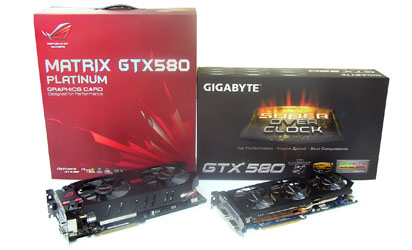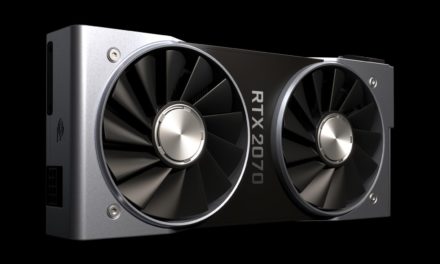
We tried: GIGABYTE GTX 580 SOC vs ASUS GTX 580 Matrix Platinum

Now we know everything there is to know about the two cannons except the most important thing: how they performed in our test applications. This time the results are summarized in a table, in addition to the basic clock measurements, the scores measured at 950/4600 MHz and the FPS values are also indicated. The piquancy of the thing is that we managed to cross the 3-point dream limit by tuning under 30DMark Vantage.
Test results:

Cue
The ASUS GTX 580 Matrix Platinum and the GIGABYTE GTX 580 SOC are two excellent cards, not just the GeForce GTX 580 range, but also the pinnacles of a GPU controller. Engineers look for better-performing GPUs by individual testing and sorting, for which a custom printed circuit is designed, with a much more serious power supply than the factory, and a number of extra features. Cooling should not be forgotten either, as we rarely find a factory solution on these models, and partners tend to use serious, home-made cooling. Of course, what has been said is also true of the two actors in this article. Which is better? It’s hard to say, if at all, the question makes any sense at all.
It was unquestionably revealed during the tests that the GIGABYTE GTX 580 SOC was faster at the OC clocks set by the engineers, but this did not come as a surprise to us, as its operating frequencies are higher than those of the ASUS GTX 580 Matrix Platinum. Our hands are a bit tied when it comes to tuning with our own hands, as there is quite a bit of time available to experience these things. Over@locker886 gave tips for overclocking, according to which we increased the voltage of the GPUs to 1,15 V, while that of the memory to 1,75 V. The result was very similar for the two opponents, as the GPUs were boosted to 950 MHz, the shaders to 1900 MHz, and the RAMs to 4600 MHz. With more time, it is conceivable that we could have gone a little higher, but with these instant settings, these values proved to be stable.
So in terms of tuning, the two cards have very similar reserves with air cooling (this is of course also case dependent). Serious tuners - such as Over - they will find out which can last the crease in case of extreme overdriving. Examining the cooling performance, we obtained interesting data. If you can believe the MSI Afterburner 2.2 beta 5 release, the 3-fan WindForce 3X GIGABYTE solution kept the GPU at 44 degrees unloaded at a basic clock speed, but what’s more brilliant, Furmark didn’t let it go above 66 degrees even under load. A GTX 580 at 66 degrees, loaded? That's right. Meanwhile, the fan rotated between 41 and 57%, which is between 1860 and 2490 rpm, which was relatively quiet with these fans, especially since it was a GeForce GTX 580. ASUS ’three-slot cooling has also done its job.
When unloaded, the GPU showed only 35 degrees (in the summer heat), while the loaded value slipped up to 81 degrees. Unfortunately, with the ASUS GTX 580 Matrix Platinum, the Afterburner could not read speed data, but we feel that under load, these two fans run at slightly lower speeds and perhaps a degree quieter than the 3-fan WinForce 3X. The 100% fan button is a good idea on the PCB, tuners can save time and inconvenience, as there is no need to maximize the speed in software, just press the button and it will start on the air horn. Of course, if the button is pressed again, the automatic control will be active. We must also not forget the physical voltage buttons, which are also easy to use, and the LEDs (green-yellow-red) inform about the current voltage level.

If we want to find a difference between the two cards, maybe we can put it this way that the ASUS GTX 580 Matrix Platinum is a slightly more unique, a little more exclusive solution. Huge cooling, illuminated Matrix label with different colors on top of the load, 100% venti button, voltage adjustment buttons, etc. However, the GIGABYTE GTX 580 SuperOverClock is the raw power itself. Due to its higher operating frequencies, it is faster than the Matrix without splashing, and its cooling is at least as efficient. In the field of tuning, we can do the same things with it, only with our own software and not with physical buttons. In the field of tuning, with air cooling, they know similarly to nitrogen with the better, and then the big ones will tell.
The truth is that it would be hard to side with one card or the other, you don’t really have to. If you need the extra equipment found on the ASUS GTX 580 Matrix Platinum, you can get the big gun for 134, but if you are satisfied with the software machining and the huge performance, the GIGABYTE GeForce GTX 000 SOC is an anthill cheaper than the Matrix, 580 You can buy it for 127 HUF. Whatever gets into the machine will serve your owner in strength and health for many years to come. Of course, only if we don't blow it up prematurely!

The GIGABYTE GTX 580 SuperOverClock video card is available at From GIGABYTE's domestic office we got it for testing, while the ASUS GTX 580 Matrix Platinum was Domestic representation of ASUS provided us, thank you!
Thanks to the following sponsors for our permanent test components in this article:
- ASUS Maximus IV Extreme REV 3.0 - ASUS Representation in Hungary
- Kingston HyperX T1 DDR3 1600 MHz 2 x 2 GB Kit - Kingston Representation in Hungary
- Kingston SSD Now V Series 64 GB SATA2 (SNV425-S2 / 64) - Kingston Representation in Hungary
- Xigmatek NRP-HC1501 - PC Gear
- ASUS 24T1E TV Monitor - ASUS Representation in Hungary
















